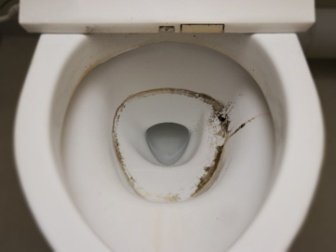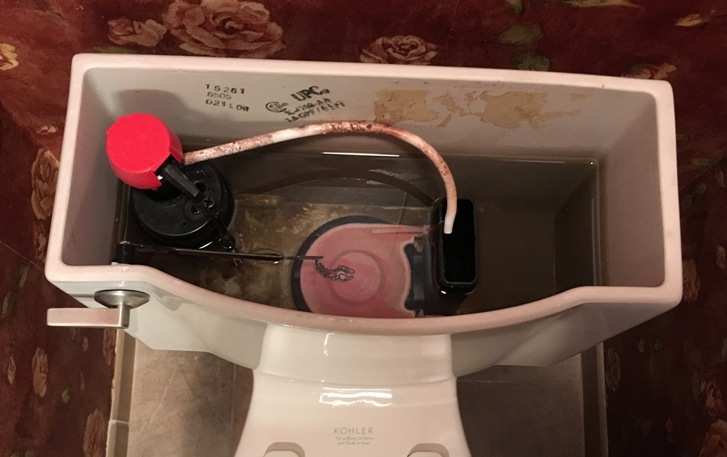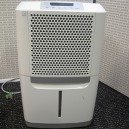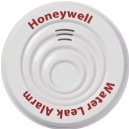Find a pre-screened local mold removal specialist Free Estimate
Find a Mold Specialist Now
Click or Call, Toll-Free 24/7
Cleaning Mold in the Toilet Bowl,
Tank, Rim, Seat and Lid
The appearance of mold in the toilet is a common occurrence, even when you don’t have serious issues with water damage or moisture build up in other areas of your home. Because of the constant presence of water in the bowl and toilet tank, mold can easily take hold and start to spread. If you’ve ever opened the lid and seen a black ring around the edge of the water level, that’s mold in the toilet. Because mold can spread easily, it’s important to thoroughly clean the toilet immediately, taking the safety precautions listed below to prevent risks to your health caused by mold spores.
What Causes Mold in Toilet?

Mold is a type of fungus that can grow on many kinds of surfaces, and most often appears when the surface is allowed to become (and remain) damp. Any room of the house can develop a mold problem as long as there has been some contact with moisture, whether that moisture comes from the outside, from plumbing problems, or through high levels of air humidity. Bathrooms are particularly susceptible to the growth of mold because there are so many ways and places for moisture to collect.
Toilets are by definition, moist environments: both the bowl and tank are partly full of water at all times except during the act of flushing. They’re also dark areas, especially when the lid is closed, and are naturally at room temperature. These conditions are perfect for mold to thrive.
Toilets that are used infrequently and not flushed often are more likely to develop a mold problem than those that are flushed many times a day. All toilets need to be cleaned regularly to prevent mold spores from growing and expanding into a larger problem.
Why is Mold Dangerous?
There are many different types of mold and they can cause numerous health problems for people exposed to the mold spores. Exposure to these molds through touch or through inhalation of airborne spores can cause skin rashes, sneezing, itchy eyes, coughing and wheezing, or nasal congestion. In people with compromised immune systems, existing health problems, or the very young or very old, mold can cause severe health complications and infections. Toilet mold can be dispersed in the air or in water droplets that spray out of the bowl during the act of flushing. Even in small amounts, mold is a threat to your health and should be removed immediately.
How to Clean Mold in Toilet
If you do discover mold growing in your toilet, don’t panic. Because toilets are made of glazed porcelain, they can be cleaned using common household cleaners (and a little elbow grease), and likely won’t need to be replaced. It’s important to remember, however, that cleaning mold requires killing and removing the fungus completely, so that it doesn’t continue to grow even after you’ve removed the surface growth.
The first thing you need to do is get a good pair or rubber gloves. Then, flush the toilet and try to drain out as much of the water as you can.
Next clean the toilet bowl with a mild household cleaner and the toilet brush or a rag to loosen the mold. Flush and repeat until all the mold appears to be gone.
Now pour a cup of bleach into the toilet bowl and let it sit for 15-30 minutes. Never use ammonia when cleaning with bleach because the mixture emits a toxic gas.
Flush and then clean the toilet bowl one last time. You can either use a diluted bleach solution (1 cup of bleach mixed in 1 gallon of water), or a commercial disinfectant, like RMR-141 Mold Killer. Scrub with the toilet brush and flush again.
If you have mold in the toilet tank, pour distilled vinegar into the tank and let sit for 20-30 minutes. Bleach is corrosive and could affect the plumbing parts in the tank, so it is better to use vinegar. Flush a few times, scrubbing inside of the tank if needed. Repeat until the mold is gone.
Finally, clean the other parts of the toilet. Spray the disinfectant or bleach solution on the exterior surfaces and seat of the toilet and allow it to sit for a few minutes. Wipe thoroughly with a damp rag, and then wipe again with just water. Dry the toilet with a paper towel.
Preventing Mold in the Toilet
The best way to deal with mold in the toilet is to prevent it. Clean your bathroom including the toilet regularly – once a week is a good cleaning schedule. Use anti-fungal sprays on a regular basis. You can put borate (Borax) in the toilet to help prevent the growth of mildew and mold. This can be purchased in the laundry aisle of any store.
Take steps to reduce the moisture in your bathroom. Use a shower fan that vents to the outside and run it during and after showers and baths. If you don’t have a fan installed, open a window or run a dehumidifier.
Always repair plumbing leaks promptly. If you see or suspect a leak around your shower, sink or toilet, fix it if you can or call a plumber immediately.
Get Professional Help
Mold in the toilet can usually be easily cleaned with some effort and common household cleaners. However, if you suspect you may have a larger mold problem in your bathroom, you can use this link to get a list of mold remediation professionals in your area. These professionals will give your home a free inspection, and will provide a free estimate for mold remediation if it is needed.
Return From Mold In Toilet To Our What To Do About Mold Page
Free Home Inspection By A Mold Removal Specialist
Search This Website
Recent Articles
-
See Our 5 Recommended Mold Removal Companies in Covington, KY
Apr 16, 25 12:59 PM
-
See Our 5 Recommended Mold Removal Companies in Wheaton, IL
Jun 20, 24 10:33 AM
-
See Our 5 Recommended Mold Removal Companies in Aberdeen, SD
Oct 08, 21 04:05 PM





